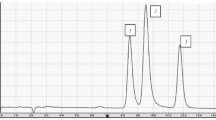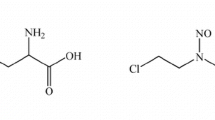Summary
A newly developed method for extracting and measuring methimazole in biological fluids was used to study the pharmacokinetics of methimazole in two euthyroid and eight hyperthyroid subjects. The volume of distribution approximated total body water; the biological half-life was 2–3 h in euthyroid and about 6 h in hyperthyroid patients. Total clearance was lower in hyperthyroid patients than in euthyroid subjects, and it did not increase after thyroid function was normalized. Bioavailability in euthyroid subjects was greater than 1 but only 0.5 in hyperthyroid subjects. The reasons for these observed differences are not known.
Similar content being viewed by others
Abbreviations
- AUC:
-
area under the serum concentration — time curve
- HCl:
-
hydrochloric acid
- HPLC:
-
high pressure liquid chromatography
- M:
-
molar
- ml/min:
-
milliliter per minute
- N:
-
normal
- NaOH:
-
aqueous sodium hydroxide
- ng/ml:
-
nanogram per milliliter
References
Baltzer J, Lartz HG, Van Zwieten PA (1975) Serumspiegel und Urinausscheidung von14C-thiamazol bei Patienten mit Schilddrüsenüberfunktion. Dtsch Med Wochenschr 100:548–552
Burrell CD, Fraser R, Doniach D (1956) The low toxicity of carbimazole. Br Med J 23:1453–1456
Burrell CD (1956) Fatal marrow aplasia after treatment with carbimazole. Br Med J 23:1456
Dahlberg PA, Karisson FA, Lindstrom B, Wide L (1981) Studies of thyroid hormone and methimazole levels in patients with Graves' disease on a standardized drug regimen. Clin Endocrinol 14:555–562
Jansson R, Dahlberg PA, Lindström B (1983) Comparative bioabailability of carbimazole and methimazole. Int J Clin Pharmacol, Ther Toxicol 21:505–510
Jansson R, Dahlberg PA, Johansson H, Lindström B (1983) Intrathyroidal concentrations of methimazole in patients with Graves' disease. Clin Endocrinol Metab 57:129–132
Marchant B, Papapetrou DP, Alexander WD (1975) Relation between thyroid iodine content and the accumulation and oxidation of35S-methimazole in the rat. Endocrinology 97:154–161
Nabil N, Miner DJ, Amatruda JM (1982) Methimazole: An alternative route of administration. Clin Endocrinol Metab 54:180
Pittman JA, Beschi RJ, Smitherman TC (1971) Methimazole: Its absorption and excretion in man and tissue distribution in rats. Clin Endocrinol 33:182–185
Skellern GG, Stenlake JB, Williams WD, McLarty DG (1974) Plasma concentrations of methimazole, a metabolite of carbimazole, in hyperthyroid patients. Br J Clin Pharmacol 1:265–269
Skellern GG, Knight BI, Low CKL, Alexander WD, McLarty DG, Kalk WJ (1980) The pharmacokinetics of methimazole after oral administration of carbimazole and methimazole in hyperthyroid patients. Br J Clin Pharmacol 9:137–143
Taurog A (1976) The mechanism of action of the thioureylene antithyroid drugs. Endocrinology 98:1031–1046
Author information
Authors and Affiliations
Additional information
Dedicated to Professor Hans J. Dengler on the occasion of his 60th birthday
Rights and permissions
About this article
Cite this article
Hengstmann, J.H., Hohn, H. Pharmacokinetics of methimazole in humans. Klin Wochenschr 63, 1212–1217 (1985). https://doi.org/10.1007/BF01733780
Received:
Revised:
Accepted:
Issue Date:
DOI: https://doi.org/10.1007/BF01733780




